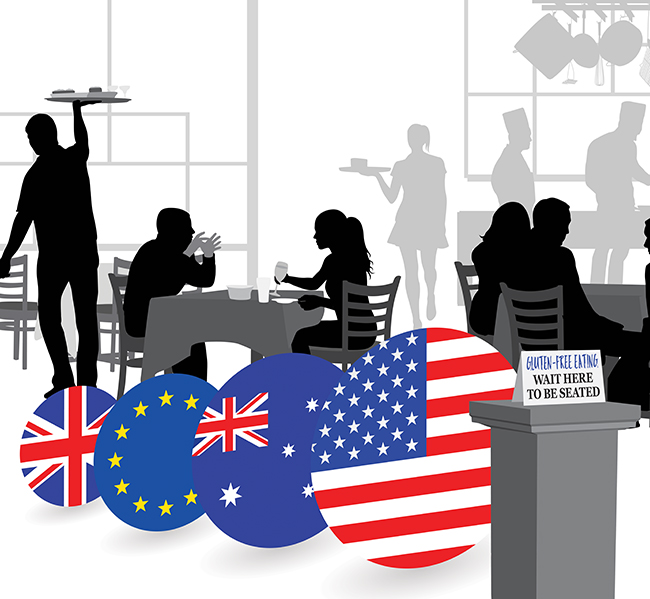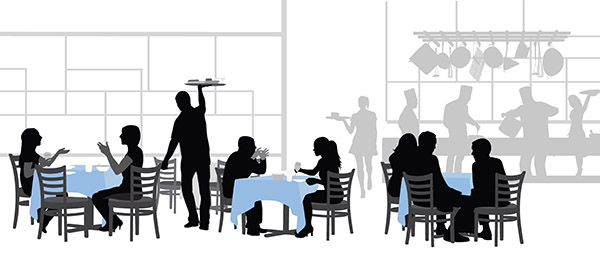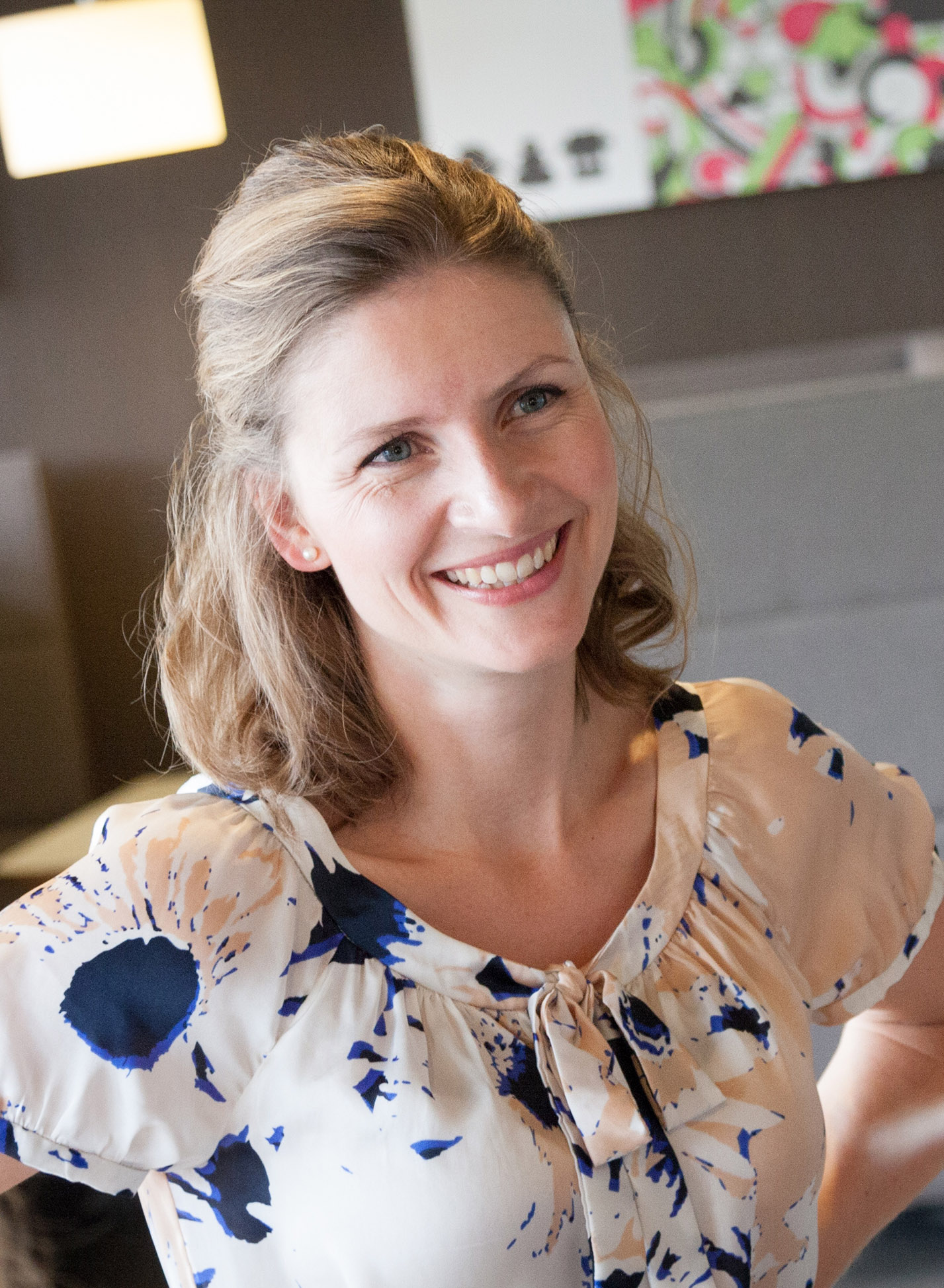The UK has thankfully made big strides in the last two decades in terms of providing gluten-free options. But, asks Ali Walsh, are other countries still showing us the way forward?

In 2001 I moved to Australia and was astonished by the range of gluten-free food available. They even knew the difference between gluten-free and low gluten – a set of terms the UK is only starting to introduce 15 years on.
Then, the situation in England was pitiful – most people didn’t know what gluten-free meant and there certainly wasn’t a free-from aisle. I wrote to a major supermarket to ask if they could label food if it was gluten-free. They said it would take too much time.
Thankfully, times have changed. But have they changed enough?
You’re abroad and ordering with your coeliac card at a restaurant seems a doddle. You find out diagnosis for coeliac disease seems swifter and simpler overseas. Or there’s a holiday kids’ club whose expert knowledge on non-edibles means you don’t worry about the playdough containing wheat. It’s hard to shake the suspicion other countries are still light years ahead.
So how true is your gut feeling (if you’ll pardon the pun)? Are we really behind the rest of the world when it comes to going gluten-free?
The US market
According to the statistics poll site Statista, $1.77 billion is spent annually on gluten-free food in the United States alone, which makes up more than 50% of the amount spent globally. Statista predicts the free-from market will rise in the US to $23.9 billion by 2020.
Compare this to UK stats and it’s clear the US spends a lot more. In 2014, we spent a tenth of what the States did. Admittedly, the US has five times the population, but comparatively we’re still buying half the amount of gluten-free food, and we all know that demand creates more products.
The influence of the EU
The Association of European Coeliac Societies (AOECS) counts 35 countries as members, including the UK. Ten (not, sadly, including the UK) have taken part in a study called PreventCD, to see if it’s possible to stop people getting coeliac disease. Although no conclusive results have yet emerged, learning is clearly taking place. The more understanding we have of coeliac disease and why people get it, the better.
For now, we have to adhere to the same labelling laws as Europe. New EU regulations about gluten-free labelling mean only the terms ‘gluten-free’ or ‘low-gluten’ will be permitted on food. A qualifying statement can follow (such as ‘suitable for coeliacs’), but the statement can’t stand on its own.
Regardless of what you’re used to reading, it makes sense. Who wants to decipher confusing terms such as NGCI (no gluten-containing ingredients), ‘made in a factory that handles gluten’ and ‘may contain gluten’? They mean different things to different people. All of them pose the risk of cross-contamination (but try telling that to the well-meaning relative who’s kindly bought in special food for you).
Slimming down the permissible terms on nutrition information labels is logical, but it’s Europe we have to thank, and unless the political decision is changed, Brexit will mean these terms may alter after May 2018.
What does the rest of the world do instead of a prescription?
Canadian residents receive tax deductions for the extra cost of gluten-free food, as do the Irish. In Italy, diagnosed coeliacs receive vouchers for money off gluten-free food (the equivalent of around £115 a month). It makes sense. Why should we go to the doctor for our food? Wouldn’t you rather have the Italian system?
Public understanding
But that doesn’t mean we’re sitting idle. You may have seen the adverts promoted by Coeliac UK entitled ‘Is it coeliac disease?’ The images don’t pull their punches: mouth ulcers and diarrhoea are clearly identifiable.
But what’s been the effect? Are they hoping people will self-diagnose and take themselves to the doctor for tests rather than suffer with a range of symptoms and constant misdiagnoses?
The answer from Coeliac UK is that half a million people in the UK are undiagnosed and they want this to change. By campaigning for greater awareness, they’re hoping this statistic will be vastly reduced.
According to Nottingham University, the number of diagnosed coeliacs has quadrupled in England in the last 20 years. That means for every 25 people diagnosed in 1996, there are 100 being diagnosed today. The adverts can only help that figure rise even more.
Availability of gluten-free food in shops, cafes and restaurants
It’s been nearly two years since the UK complied with EU law to ensure all food (whether freshly prepared or packaged) is sold with a clear indicator of 14 different allergens, including gluten. But the laws aren’t enough to ensure categorically you’ll be safe when you eat out. Issues of staff ignorance and cross-contamination are still prevalent.
A petition to give a ‘mandatory course/examination on food and drink for allergies and intolerances’ has been raised by Richard Shirley, a chef whose family’s dietary needs have made him determined to make a change. But is this what it’s come to: the people having to change the system rather than the government stepping in?
Differences at McDonald’s
If you’ve travelled recently to other European countries, like Spain, you’ll know that McDonald’s now provide gluten-free buns if you request them. But it’s not the same in the UK. I received the following statement when I contacted McDonald’s: “We regret at present we don’t have any plans to introduce gluten-free buns onto our menu… sorry for any disappointment this causes.” Clearly, the UK has some catching up to do.
Media representation
It’s hard to forget the Daily Mail’s gaffe last year, when it claimed gluten-free products were costing the NHS millions (£116 million, it stated). It also claimed the majority was spent on junk food such as pizza and doughnuts.
The damage done by such an article always fuels the opinionated but uninformed (a spate of outraged blog posts followed in the wake of the Mail’s accusations). Coeliac UK wisely corrected the Daily Mail to a more accurate £26.8 million, and made it clear this had been spent mainly on gluten-free staples such as bread and pasta. Thankfully, an apology was made, and the paper has since published more accurate articles on coeliac disease and its effects, including a lengthy piece on the actress Caroline Quentin, a patron of Coeliac UK.

Celebrity endorsements
Unhelpfully, there aren’t many people famous in the UK with coeliac disease. Arguably, the biggest celebrity gluten-avoiders aren’t English and cut out gluten for other reasons, which often makes public perception worse. How many times have you heard people ridiculing Novak Djokovic’s faddy diet or Gwyneth Paltrow’s preposterous regime? In 2014, Jennifer Lawrence described the gluten-free diet as “the new cool eating disorder”.
But celebrity endorsement clearly helps, whatever the backlash. The old adage ‘there’s no such thing as bad publicity’ is true: the more people talk about gluten, the more likely we’ll get the research, awareness and information we need to make life easier.
Luckily, too, it seems chefs are beginning to take note. It’s an increasingly regular occurrence for TV cooks to demonstrate gluten-free cooking on a high-ranking television programme – Phil Vickery on ITV’s This Morning, to name one – which is pretty impressive when they don’t need to avoid gluten themselves.
Does the percentage of coeliacs in each country have an effect?
It would be obvious why other nations do more research and have better awareness of gluten if specific countries had a higher percentage of coeliacs. However, the generally agreed conclusion is that 1% of the population is affected regardless of location (with the exception of certain parts of Africa).
Where the UK meets the same requirements as other countries
Labelling of gluten-free products in the UK is as strict as anywhere else: the food must contain under 20ppm (parts per million) of gluten or it can’t be deemed gluten-free.
How you can make things better
The UK might not be a gluten-free world leader, but there are always ways you can help. Don’t underestimate the power of social media. If you’re on Facebook or Twitter, you can champion those who provide gluten-free products with a like, comment, share or retweet or contact those who don’t yet make products gluten-free to persuade them to be more inclusive. After all, there’s nothing a business owner likes more than seeing pound or dollar signs at the sight of untapped potential.
 About our expert: Ali Walsh was diagnosed with coeliac disease nearly 20 years ago, at a time when free-from food was scarce. She started her own cake business because there was a lack of fresh gluten-free cake on offer. Ali feels if you can’t eat a particular food, you shouldn’t feel deprived, and has created recipes so delectable that even people without dietary requirements clamour for her bakes. A regular on BBC radio, Ali often advises on managing diets. www.thelocalbakehouse.com.
About our expert: Ali Walsh was diagnosed with coeliac disease nearly 20 years ago, at a time when free-from food was scarce. She started her own cake business because there was a lack of fresh gluten-free cake on offer. Ali feels if you can’t eat a particular food, you shouldn’t feel deprived, and has created recipes so delectable that even people without dietary requirements clamour for her bakes. A regular on BBC radio, Ali often advises on managing diets. www.thelocalbakehouse.com.
